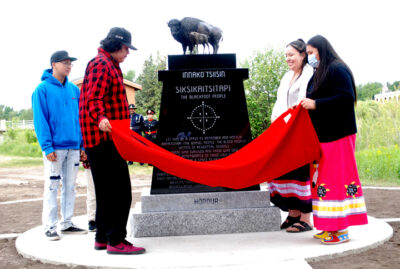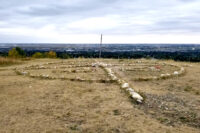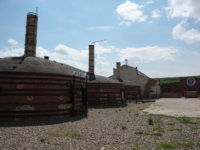Monument honours victims of Baker Massacre, residential schools
By Dale Woodard on June 22, 2021.
 Herald photo by Dale Woodard
Cardston High School Students Cachius Hungry Wolf, Hunter Heavy Runner, Avery Many Bears and Kiara Rabbit unveil a monument Saturday in Cardston they helped organize and design in memory of those lost in the Baker Massacre of 1870, as well as honouring and remembering victims of residental schools.
Herald photo by Dale Woodard
Cardston High School Students Cachius Hungry Wolf, Hunter Heavy Runner, Avery Many Bears and Kiara Rabbit unveil a monument Saturday in Cardston they helped organize and design in memory of those lost in the Baker Massacre of 1870, as well as honouring and remembering victims of residental schools.Three years ago, students at Cardston High School got a valuable history lesson.
For the past three years, those students and their teacher not only took the lesson to heart, but have now built a monument of remembrance and hope in Cardston.
Back in 2018, a group of Cardston High School Blackfoot students and their teacher Kara Baldwin, read the account of the Baker Massacre of 1870, where approximately 217 peaceful Blackfeet people were killed by the United States Cavalry in Montana.
Together, they wondered why they had never heard about the tragic event, even though some of the descendants of the survivors live in Cardston and attend Cardston High School. So they decided to organize and plan for a monument.
On Saturday, students, teachers, elders and other dignitaries gathered for the official unveiling in what is to become a healing garden – named the Riverside Healing Garden and Monument – in the townsite of Cardston in hopes of building and developing stronger relationships between Indigenous and non-Indigenous peoples.
The site will also be a place to remember and honour Aapaitsitapi – The Weasel People: The Blood People – victims of residential schools in addition to remembering those lost during the Baker Massacre.
“It really started out just as a conversation with a group of Blackfoot students I was working with,” said Baldwin. “I had read an article about the Baker Massacre. I had never heard about it. We live so close and some our students are direct descendants from some of the survivors and none of the students had heard about it, either.
“We thought how tragic and sad that we know so much about other events, but not this one. So the conversation emerged to a project which emerged to this coming together today.”
Baldwin said she initially challenged the students to draw what they envisioned a monument would look like to honour and bring knowledge about the Baker Massacre.
“But also about residential schools because we thought that was really important knowledge that needed to get out there,” she said.
One of those students, Cachius Hungry Wolf – who was at Saturday’s unveiling – drew a design of the monument the students ultimately settled on.
“It emerged to fundraising events through grants, through the town (which) has been on board 100 per cent from Day 1,” said Baldwin.
Topped with a buffalo, the monument documents the Baker Massacre on the Bear River where on January 23, 1870 during minus 30-degree weather, Blackfeet Chief Heavy Runner’s peaceful camp was attacked by the United States Cavalry in the early morning hours along the banks of Bear River in Montana, killing approximately 217 Blackfeet women, children and elderly.
The other side of the monument, facing east, honours the victims of residential schools, both those who survived and died.
Among those students who were a part of the initial design three years ago was Avery Many Bears, now 20-years-old.
“This is amazing. Seeing it from a little piece of paper to right now,” said Many Bears. “At first it started with a class and then it went to another class. I don’t know how many hours we spent on this and how many days and months we spent on this.”
On Saturday morning, Many Bears joined fellow students Hungry Wolf, Hunter Heavy Runner and Kiara Rabbit in officially unveiling the monument.
“It’s really special for me,” said Many Bears. “I’ve never seen anything like this before. Just seeing it is really special.”
Saturday’s ceremony featured speeches, music from a drum group and concluded with a round dance in a full circle around the monument.
“We’ve invited various community members as well as the students and the elders who have been key parts,” said Baldwin. “We’ve really tried hard to work with the elders along the way, including picking the site and which direction the buffalo should be facing. The students and I are learning about practices and culture and traditions along the way.”
With Indigenous Awareness Week kicking off this week as well as the news of the discovery of the remains of 215 children found buried at a former Kamloops Indian Residential School last month, Baldwin said she and her students talked about the timing of Saturday’s unveiling a few days prior to the event.
“This has been three years in the making, but for it to come out now when all of the bodies are being found at the schools, we’re hoping this will provide a space that people can come and connect and get to know each other.”
Baldwin said Saturday’s unveiling is just Stage 1 for the site located just off Cardston’s main street, across from the provincial building.
“We still need a lot of fundraising to happen for the sidewalks, benches and more informational facts we want to see happen,” she said. “We want to get more Indigenous artwork in the area. So the students named it the Riverside Healing Garden and Monument. So we want to develop the garden further. We’re hoping the schools will use it as a space to bring students down and use it as an educational space.”
Among the speakers on Saturday was Ramona Big Head, who did her thesis on the Baker Massacre and is now the principal at Kainai High School on the Blood Reserve and a PhD candidate out of British Columbia.
Big Head’s great, great grandmother, Holy Bear Woman, was a child at the massacre who eventually married and came to the Canadian side of the border.
“That’s where all of us are descendants,” said Big Head. “That’s how many generations back. It wasn’t even that long ago.”
Big Head expressed her gratitude to Baldwin and her students for reading her thesis and research on the Baker Massacre.
She also went to their classroom and shared her story with the students.
“Then they put this together and in the town of Cardston this is so important,” said Big Head. “We are so close to the border, it’s acknowledgement that this happened. You’re not going to find monuments like this in the state of Montana. But here, I commend Kara Baldwin and her students for doing this. It’s so important and I know this is going to live on for years and I’m looking forward to bringing my children, my grandchildren and my own students here so they will know. We can’t forget this story. It’s very real and it’s important.”
Follow @dwoodardherald on Twitter
3-2




